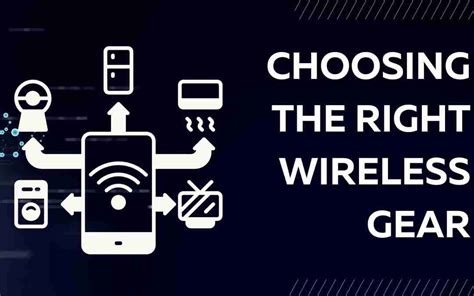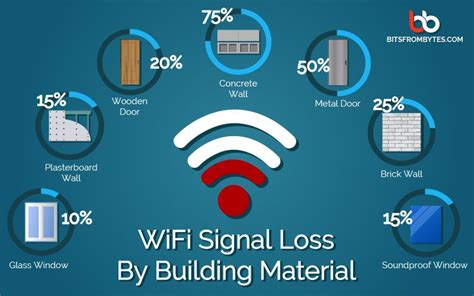Are you tired of experiencing those annoying cut outs and drops in your wireless audio connection? Do you wish you could enjoy your favorite tunes without being confined to a small area? Look no further! In this article, we will explore innovative techniques to enhance the range of your wireless audio devices, eliminating potential obstacles and expanding your audio reach.
Long gone are the days of being tethered by cables and cords! Thanks to the wonders of wireless technology, you can now enjoy the freedom of moving around while still being able to listen to your favorite music or take calls. However, as with any technology, there are limitations that can affect the quality and distance of the signal.
What if we told you that there are effective methods you can implement to extend the range of your Bluetooth headphones? Yes, you heard it right! By understanding the factors that can impede your wireless audio range and by adopting the proper techniques, you can dramatically improve the reach of your headphones.
Imagine listening to your favorite playlist, completely uninterrupted, while roaming around your home or office! Whether you're in the kitchen, the living room, or even outside on the patio, with these proven strategies, you can minimize signal drops and maintain a crystal-clear connection. So, let's dive into the world of wireless audio and discover the secrets to expanding your sound experience!
Understanding Bluetooth Technology and its Limitations

When it comes to the world of wireless audio, Bluetooth is a popular technology that allows devices to communicate without the need for cables or wires. Although Bluetooth has become widely adopted and offers convenient wireless connectivity, it's important to understand its limitations to make the most of your Bluetooth headphones.
Bluetooth operates in the 2.4 GHz frequency range, which is commonly used by many other wireless devices such as Wi-Fi routers, microwave ovens, and cordless phones. This frequency range can sometimes become crowded, leading to potential interference and reduced signal strength for Bluetooth devices. Understanding these limitations will help you optimize your Bluetooth headphone usage.
- Range: Bluetooth technology typically has a range of up to 33 feet (10 meters) in an ideal, unobstructed environment. However, walls, furniture, and other physical objects can significantly reduce this range. It is important to consider the distance between your Bluetooth source device and your headphones to maintain a strong and stable connection.
- Signal Interference: As mentioned earlier, the 2.4 GHz frequency range used by Bluetooth is shared with various other devices, which can lead to signal interference. Microwave ovens, in particular, can cause temporary interference when in use. Additionally, other Bluetooth devices in close proximity can also interfere with each other's signals. Minimizing the number of competing devices and reducing the distance between your source device and headphones can help mitigate signal interference.
- Data Compression: Bluetooth uses a form of data compression called "lossy" compression, which means that some audio quality may be sacrificed to ensure smooth wireless transmission. While advances in Bluetooth technology have improved the audio quality over the years, it is still important to note that the audio transmitted wirelessly may not match the same level of quality as a wired connection.
- Battery Life: Utilizing Bluetooth technology requires power from both the source device and the headphones. This wireless transfer of data can drain the battery life more quickly compared to a wired connection. It is crucial to keep the battery levels of both your source device and headphones in mind for uninterrupted audio streaming.
By understanding these inherent limitations of Bluetooth technology, you can make informed decisions and enhance your experience with wireless audio. Being mindful of the range, signal interference, data compression, and battery life associated with Bluetooth headphones will help you optimize your usage and enjoy the convenience of wireless audio.
Enhancing Bluetooth Signal Strength: Placement and Line of Sight Optimization
When it comes to improving the strength of your Bluetooth signal, the placement of your devices and maintaining a clear line of sight can play a crucial role. By strategically positioning your devices and ensuring minimal obstructions, you can optimize the performance and range of your wireless audio experience.
Placement: |
Choose an ideal location for your Bluetooth devices that minimizes interference and maximizes signal strength. Keep in mind that different devices may have variations in performance, so experimenting with different placements is recommended. Avoid placing your devices near large metal objects or heavy obstacles, as they can block or weaken the signal. Try to position your devices in an open area, away from walls or other signal-obstructing objects, to allow the signal to travel freely. Additionally, elevating your devices can help extend the range, as Bluetooth signals tend to have better transmission when the devices are placed at higher altitudes. Furthermore, be mindful of the distance between your Bluetooth devices. A closer proximity between the transmitting device (e.g., smartphone) and the receiving device (e.g., headphones) can result in a stronger connection and fewer signal dropouts. |
Line of Sight: |
Having a clear line of sight between your Bluetooth devices can significantly enhance signal strength and range. This means minimizing obstructions such as walls, furniture, or other obstacles that may dampen or block the signal. If you are experiencing a weak connection, try adjusting your devices so that they have a direct line of sight with each other. Avoid positioning your devices in places where the signal needs to pass through multiple walls or objects, as this can lead to signal degradation. Remember that certain materials, such as concrete or metal, can interfere with the signal strength. If your devices need to be placed in separate rooms separated by walls, consider relocating them to reduce the number of obstacles between them. |
By taking into account the placement of your Bluetooth devices and ensuring a clear line of sight between them, you can optimize the strength and performance of your wireless audio connection. Experiment with different positions, elevations, and distances to find the best setup that suits your specific environment and devices.
Choosing the Perfect Wireless Device for Enhanced Connectivity

When it comes to optimizing your audio experience and extending the reach of your wireless capabilities, selecting the right Bluetooth device plays a crucial role. Whether you're a music enthusiast, a professional needing reliable communication, or simply looking for convenience in your daily activities, finding a Bluetooth device with exceptional range is essential.
Having an extended range ensures a seamless audio experience without any interruptions or loss of signal. The right Bluetooth device allows you to enjoy your favorite music, podcasts, or even conduct business calls without being restricted by the confines of a limited range. With a reliable connection, you can move freely within your home, office, or outdoor spaces while staying connected wirelessly.
To choose the best Bluetooth device for extended range, consider the following key factors:
1. Signal Strength: Look for devices that offer a strong signal strength to ensure a stable and reliable connection even when you're farther away from the audio source.
2. Bluetooth Version: Opt for the latest Bluetooth versions, such as Bluetooth 5.0 or higher, as they provide improved range and better compatibility with devices.
3. Antenna Design: Devices with external or high-gain antennas tend to offer better range and signal penetration, allowing you to stay connected even through walls or obstacles.
4. Battery Life: Consider the battery life of the Bluetooth device, especially if you plan on using it for extended periods. Choose a device that can offer a long-lasting battery to avoid frequent recharging or interruptions.
5. Brand Reputation: Research and choose reputable brands known for their quality and reliability in providing extended Bluetooth range devices. Reading customer reviews can help narrow down your options and ensure a satisfactory purchase.
By taking these factors into consideration and understanding your specific needs, you can confidently choose a Bluetooth device that extends your wireless audio reach and provides an exceptional audio experience.
Utilizing Signal Boosters and Amplifiers for Enhanced Connectivity
In this section, we will explore the possibilities of utilizing signal boosters and amplifiers to improve the distance and reliability of your wireless audio connection. By employing these devices, you can extend the reach of your audio transmission without compromising on the quality of sound.
One effective way to enhance the range of your wireless audio connection is by incorporating signal boosters. These devices work by amplifying the weak signals, thereby providing a stronger and more stable connection. Whether you are enjoying music, watching movies, or engaging in conference calls, signal boosters can help deliver a seamless audio experience.
Amplifiers are another valuable tool that can significantly improve the range of your wireless audio devices. These devices work by increasing the power of the audio signal, allowing it to travel further distances while maintaining its clarity. By utilizing amplifiers, you can overcome obstacles such as walls or interference that might hinder the reach of your wireless audio connection.
When selecting a signal booster or amplifier, consider factors such as compatibility with your wireless audio devices and the specific range extension requirements you have. Some amplifiers may provide better long-range capabilities, while others may be more suitable for smaller spaces. Additionally, ensure that the chosen device meets the necessary technical specifications for optimal performance and compatibility.
It is important to note that signal boosters and amplifiers are not a one-size-fits-all solution. The effectiveness of these devices will vary depending on various factors such as the quality of the signal source, the presence of signal interference, and the specific environment where the wireless audio connection is being used. Therefore, it is crucial to carefully evaluate the capabilities of signal boosters and amplifiers before making a purchase.
| Benefits of Signal Boosters and Amplifiers: |
|---|
| 1. Extending the range of wireless audio devices |
| 2. Improving signal strength and stability |
| 3. Overcoming obstacles and interference |
| 4. Enhancing the overall audio experience |
In conclusion, signal boosters and amplifiers can be valuable tools for enhancing the range of wireless audio devices. By incorporating these devices, users can extend the distance and reliability of their wireless audio connections, providing a more seamless and enjoyable audio experience.
Overcoming Obstacles: Dealing with Interference and Signal Blockage

In the realm of expanding the reach of your wireless audio experience, there are various challenges that can impede your ability to enjoy uninterrupted sound. This section aims to address the obstacles of interference and signal blockage, offering insights on how to overcome these hurdles.
Interference: Interference occurs when external signals disrupt the transmission of your wireless audio. This can result in distortions, dropouts, or complete loss of audio. To mitigate interference, it is essential to identify potential sources and take appropriate measures. Keeping electronic devices such as phones, Wi-Fi routers, and microwaves away from your Bluetooth headphones can help reduce signal interference. Additionally, selecting headphones that utilize frequency-hopping spread spectrum technology can enable them to adapt and avoid congested signal frequencies, enhancing your audio experience.
Signal Blockage: Signal blockage refers to physical barriers or obstacles that obstruct the transmission of audio signals. Walls, metal surfaces, and even human bodies can weaken the Bluetooth signal, significantly impacting range and sound quality. To overcome signal blockage, consider optimizing your headphone placement by avoiding direct obstructions and positioning yourself closer to the audio source. Ensuring a clear line of sight between the audio source and your headphones can help minimize signal blockage and maintain a stable connection.
In overcoming interference and signal blockage, it is crucial to experiment and adapt to your specific environment. Each situation may present unique challenges, but by understanding the factors that affect your wireless audio reach and implementing appropriate strategies, you can optimize your headphone experience and enjoy seamless connectivity.
Advanced Techniques: Extending Bluetooth Range with External Antennas
Enhancing the scope of wireless connectivity can be achieved through the implementation of advanced techniques utilizing external antennas. By utilizing these cutting-edge methods, users can greatly increase the distance and signal strength of their Bluetooth devices without compromising audio quality or experiencing dropouts.
Fix Windows 11/10 Bluetooth Headset Low Volume and Bad Quality
Fix Windows 11/10 Bluetooth Headset Low Volume and Bad Quality by Murugan S 63,867 views 2 years ago 2 minutes, 18 seconds
FAQ
Can I increase the range of my Bluetooth headphones?
Yes, there are proven methods to extend the range of your Bluetooth headphones. These methods can help you enjoy wireless audio from a greater distance.
What is the typical range of Bluetooth headphones?
The typical range of Bluetooth headphones is around 33 feet (10 meters). However, the actual range can vary depending on factors such as signal interference and the specific Bluetooth version being used.
What can cause the range of Bluetooth headphones to be limited?
There are several factors that can limit the range of Bluetooth headphones. Some common causes include physical obstructions, interference from other wireless devices, and the Bluetooth version being used.
Are there any devices or accessories that can help boost the range of Bluetooth headphones?
Yes, there are devices and accessories available that can help extend the range of Bluetooth headphones. These include Bluetooth range extenders, signal boosters, and even smartphone apps designed to optimize Bluetooth connections.




